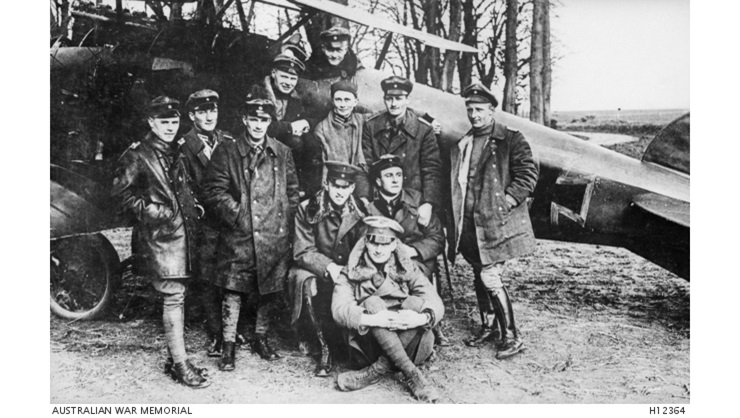Over the moon like a Led Zeppelin
Apollo astronauts and a classic rock 'n' roll band
Think way back to the days when you were sitting on your bedroom floor, rockin’ out to Led Zeppelin’s second album, while your parents yelled, “Turn down that noise!” Perhaps between Whole Lotta Love and the Lemon Song you perused the faces on the album cover and recognized the band members: Robert Plant, Jimmy Page, John Paul Jones, and John Bonham. Only space geeks would have noticed that one of the faces was that of Apollo 8 astronaut Frank Borman. Was Borman a Led Zeppelin groupie?
The cover art of the 1969 album was based on an old photograph of Jagdstaffel 11 (Fighter Squadron 11), the German World War I aerial squadron known as the “Flying Circus,” led by Baron Manfred von Richthofen, the infamous Red Baron. (A little-known fact is that Snoopy never did shoot down the Red Baron.) The album artist, David Juniper, replaced four of the 11 German pilots’ faces with those of Led Zeppelin’s members, and the faces of the remaining pilots with celebrities. He added beards and sunglasses to some of the faces and cut one pilot out of the original image altogether. When Juniper was conceiving the album art, Apollo 11 had just made the first landing on the moon, so he decided to add an image of Neil Armstrong to the cover. However, he mistakenly used a photo of Frank Borman, who commanded Apollo 8, the first flight to orbit the moon. Borman stands in the back row, second from right, behind three seated band members.
The other figures remain difficult to identify, especially because Juniper added beards and sunglasses to many. In 2007, Juniper said the figure second from left is Miles Davis, but earlier he claimed it was musician Blind Willie Johnson, so even the artist doesn’t know. It’d take a lot of searching through photos to confirm their identities.
Juniper removed the aircraft in the original photograph, which seems to be an Albatros D.III, but someone with more knowledge of World War I aircraft will have to identify it. (Just my opinion—removing it was a blasphemy.) With the airplane’s removal went the Red Baron himself, who was seated in the cockpit. Juniper added abstract clouds and the outline of the Hindenburg Zeppelin on a brown background, which inspired the album’s nickname, Brown Bomber.
A few people have gotten Borman to autograph their Led Zeppelin II albums at autograph signing events. Now, that’s a real space collectable.
Again?
For Led Zeppelin’s sixth album, Physical Graffiti (1975), another artist attempted to include Armstrong into the cover. However, this artist also confused the astronauts’ identities, as the image is actually of astronaut Buzz Aldrin.
The artist, Peter Corriston, created a die-cut album sleeve depicting a New York City apartment building, with the windows cut out so that various images from inner sleeves are interchangeably visible. One sleeve reveals the album title, while another reveals images of famous people. In the upper right window of the building is an image of an astronaut on the moon, which many rock ‘n’ rollers have incorrectly identified as Armstrong. Of course, all space geeks know that it is the iconic image of Aldrin in a photo made by Armstrong. W.C. Fields, Lee Harvey Oswald, Marcel Duchamp, and Pope Leo XIII, also appear, along with Led Zeppelin band members. The album design was nominated for a Grammy Award for best album packaging.
You can visit the building depicted on the album cover at 96-98 St. Mark’s Place in the East Village of Manhattan, New York City. There’s now a tea shop in the ground floor named “Physical Graffitea.” Since Led Zeppelin was a British band, maybe they buy their tea here?
Did NASA approve?
When Early Days: The Best of Led Zeppelin Volume One was released in 1999, the album cover art featured the Led Zeppelin band members in Apollo space suits, seated in front of a star-studded night sky and a modified Apollo mission logo. The photo used for that album was an official NASA photo of the 1971 Apollo 14 crew, astronauts Alan Shepard, Edgar Mitchell, and Stuart Roosa, who completed the third mission to land on the moon. Since there are four band members, but only three Apollo crew members, the fourth band member in a space suit was inserted into the photo.
Behind the band (crew) members is a Led Zeppelin logo, which is repeated as a patch on their spacesuits. Originally, it was the mission logo of Apollo 14, but the artist added the “man in the moon” with a rocket piercing his eye. That image was inspired by the 1902 film, Le Voyage dans la Lune. Instead of “Apollo 14” on the gold edge of the logo, it reads “Led Zeppelin.”
Early Days featured selections from the band's 1968 to 1971 albums. A second volume, Latter Days, was released in 2000 with tracks from their 1973 to 1979 albums. It used the same photo of the band members as astronauts.
The Apollo moon landings certainly inspired a generation of pilots, scientists, engineers, and, perhaps, a few rock ‘n’ roll musicians and graphic artists.




